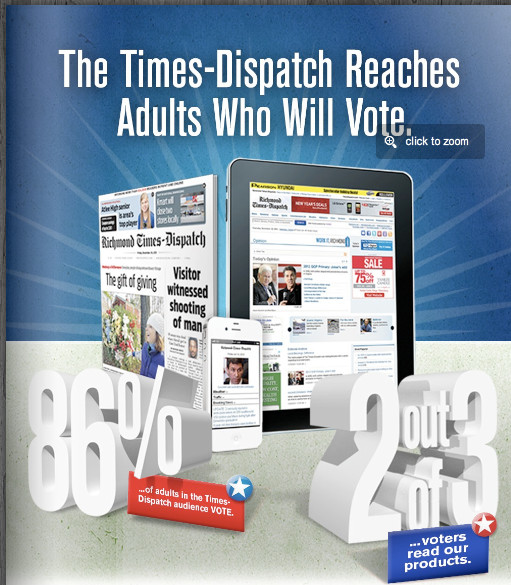Pricing and packaging to double political ad revenues
Here's how Richmond Media Group generated $200,000 plus per quarter selling political ads
Summary: Newspaper companies are also in a unique position to capitalize on the expanding pool of dollars. To maximize dollars during the peak season, they face a number of challenges:
a. To make a clear case
b. To make it simple to buy
c. To position competitively to take advantage of times when broadcast is oversold and over-priced.
d. To take advantage of price and timeliness issues that the U.S. Post Office now has.
Richmond Media Group has put together the best strategy and media materials we've seen. They started this plan in 2011, and by the first quarter of 2012 had already secured $200,000 in political advertising. Other local media, such as radio and broadcast can also learn from these methods of packaging digital to expand inventory.
Company: Richmond Media Group
Media: Richmond Times-Dispatch, TimesDispatch.com, Richmond.com and Richmond Suburban News
Owner: Media General
Key Executive: John W. Kelly, VP, Revenue and Business Development
Challenge: Richmond Media Group (RNG) owned by Media General, which also owns broadcast sites, has the largest print and online audiences in its marketplaces. But RMG managers knew their media properties historically underperformed in political ad sales and lacked a well-timed strategy to capture additional market share. Kelly's team decided to come up with a new plan that would:
- Increase sales pressure
- Launch an attractive competitive rate structure
- Use packages and bundles to make buying easier
- Leverage digital
- Sell across the region
Strategy: First and foremost the team decided to get an early start - having strategy sessions in the fall of the year prior to the election season. Kelly advises, “get your head ... into the political business.” The new strategy included the following plans:
a. Reach out to all campaigns and advocacy groups
Kelly's team relied on two main sources: The John Kimball Group was the primary source for candidates' contacts they provide a $500 report that includes, according to Kimball, candidates registered to run "as far down the ballot as we can get," all the way to sheriffs races and school board races.
"Most newspapers get 500 to 600 candidates statewide - and some have more." In addition, the Kimball Group picks up all the PACs from the federal election office and now has about 260 PACs, super PACs and advocacy groups. Kelly says, "This was one of the most worthwhile investments we made."
Second, the group contacted television and radio stations early and often. By law, broadcast stations are required to give contacts for their political buys and do so willingly, a great source for media who choose to utilize it.
b. Create a dedicated team
Richmond created a five-person political sales team from existing staff included people passionate about politics – on the left and right. One key rep was a real estate sales executive. The organization of the team includes a sales manager (with shared responsibilities), national rep, and three local reps for a total of five people. All these sales positions are paid on straight commission, in addition to their regular jobs.
c. Assessing - and building out - political advertising channels
Political advertising is a natural tie-in for news readers, but Media General also has a variety of multi-media opportunities and decided to add two partners to beef up its online offerings.
*Partnership with Politifact as an additional, scaleable online political news channel. Started in 2011, Politifact is a key news source for people addicted to following political news.
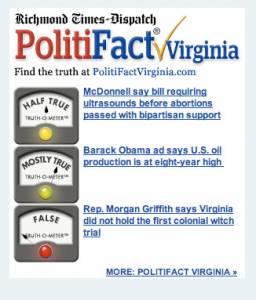
They also added Evoter.com, a start-up that posts all candidates and races and allows voters to “look-up” all of the candidates they are eligible to vote for. Evoter charges the campaigns for the right to post additional information on the site and splits 50% of the revenues with the local media company, and the media company can sell advertising exclusively across the channels.
Assessing print meant including not only the paper but also stitched covers, adhesive notes, plastic wraps, front page ads and direct door-to-door distribution of glossy inserts to compete with the post-office. Kelly advises, to think “What can you offer candidates in turns of space. We need the money so badly the newsroom gave us everything in terms of space, including strip ads on the front page, for the first time.”
Online and mobile products also heavily rely on premium corner peels and sliders on channel "front pages", but also email was added to provide extra geo-targeting.
To accomplish the latter, Richmond lined up a partnership with CityTwist.com an opt-in email provider that allows candidates to blanket a geo-targetted area.
Next, page two of the media kit focuses on the huge advantage in internet readers over local television sites. Using Scarborough Research, they could make the claim that nine of ten Dispatch website users are voters, and market dominance of 2 to three times each of the broadcast competitors:
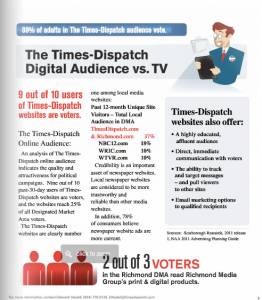
Key communications position against television.
The next part of the media kits is a highly visual walkthrough of all the products. Key elements of this section:
- No column inches, just modular sizes
- One product per page, with lots of white space
- Use of red to visually show the products for sale
- Daily rates for premium online ads, as well as competitive CPM rates
- A sales phone number at the bottom of every page
- Adding in the demographics for different products
As Kelly states, "Television is a visual medium. Buyers are used to that." Here are a couple of samples of how the products are displayed, both for traditional ads, online ads, and premiums:
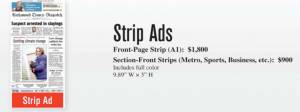
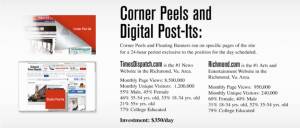
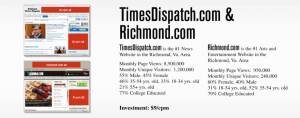
Rates were also made competitive. A mistake many companies make is over-pricing political “call-ins” – usually to national rate cards – without understanding how to utilize more aggressive competitive pricing to steal market share and increase total dollars.
A key print competitor that is especially vulnerable this year because of both rates and timeliness is the U.S. Post Office. The pull-back of delivery is a boon for newspapers who have distribution systems already in place. To position it direct mail delivery service, RMG offered: a. Guaranteed day of delivery, b. Print and deliver a turnkey solution for geo-targeting and c. Free design and quick turn-around. Pricing was also competitive at $50 to $67 per thousand for the turnkey solution with a ten-day turnaround. Here's how the glossy insert proposition is presented "a la carte":
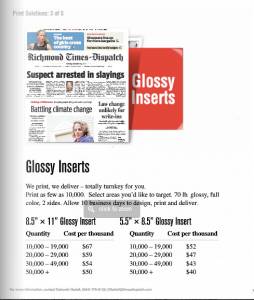
The media group pitches the unlimited inventory - especially for last minute buys - when TV and radio are apt to be sold out. This also works to pitch large accounts who stand to be “bumped” off the air when campaign season is in its peak
Packages and bundles that make it simple to buy
Political buyers are racing a river running downhill – they need newspapers to keep it simple. Richmond did this by creating simple, packages: Small, medium, large and premium; and also City, state and national. The small, medium, large and premium packages have some creative bundling ideas. Note how all these packages utilize premium positions.
Small: 25,000 color post-its printed and posted on the newspaper, 1/8 page ad, 40,000 ROS. $2990
Medium: Front page strip of the Metro News section 4x, 25,000 glossy inserts, 100,000 ROS impressions, $5405
Large: Front page strip 2x, 1/2 page 2x, 200,000 ROS impressions, 100,000 mobile impressions, $11,672
Premium: Spadea wrap, 300,000 ROS, Corner Peels 2 days, 150,000 mobile impressions, $23, 650
Here's how the packaging looks:
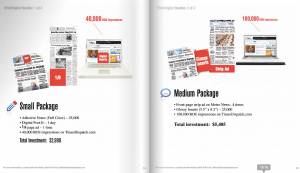
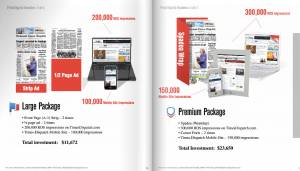
The flipbook also shows cards for specific races - awesome idea - including State Capital, Mayor's Race and Town Hall. The big difference is between statewide races and citywide races, in which different media properties were packaged according to geographical appropriateness. These packages are digital only and aimed for last-minute buys. The sites are listed with the impressions, and then there are three options, one price for all websites, one for all mobile sites and one for both together.
In this case, without hyperlocal sites, the Town Hall packages were simply smaller - but included the option for front page take over, a smart way to rev up the impact and direct response of a small spend by concentrating it into key days, rather than spreading it out of the site.

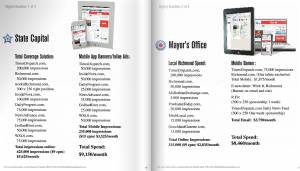
Finally, the last two pages explain the rules for political ads. And a six page newspaper was printed to showcase the same materials:
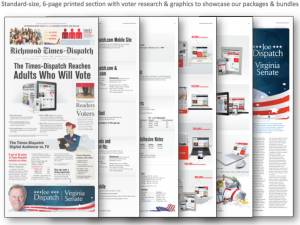
Here's a larger version of the top page:
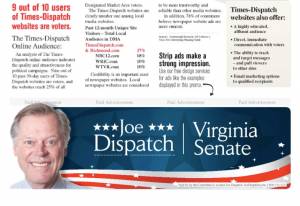
Results
By March of the election year (2012) RMG had sold $200,000 in political dollars.
Our take
John Kelly's political advertising team does so many things really well, that it is difficult to summarize their efforts in a paragraph. What we especially like:
- Attention to leading with key messages for their media, that is they make a case for the strength of both their print and digital audiences
- Competitive positioning of their strongest assets: Digital dominance
- Use of key partners to build on these strengths (evoter.com, PolitiFact, CityTwist, etc.)
- Beefing up premium options - such as spadea wraps and site takeovers - and including them in all packages as part of even small core buys, rather than unusual add-ons
- Highly visual packaging that make it easy to buy
- Focus on multi-media sales
Many thanks to John W. Kelly, VP, Revenue and Business Development, for sharing his presentation at the Newspaper Association of America, 2012 MediaXChange and responding to our analysis to ensure an accurate portrayal of this outstanding team effort.

